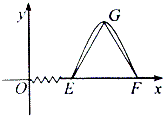题目内容
函数f(x)=Asin(ωx+ϕ)(A>0,ω>0,0<ϕ< )在一个周期内的图象如图所示,P(x,y)是图象的最髙点,Q是图象的最低点,M(3,0)是线段PQ与x轴的交点,且
)在一个周期内的图象如图所示,P(x,y)是图象的最髙点,Q是图象的最低点,M(3,0)是线段PQ与x轴的交点,且 .
.(I)求出点P的坐标;
(Ⅱ)求函数f(x)的解析式;
(Ⅲ)将函数y=f(x)的图象向右平移2个单位后得到函数y=g(x)的图象,试求函数h(x)=f(x)•g(x)的单调递增区间.试求函数h(x)=f(x)•g(x)的单调递增区间.

【答案】分析:(I)由cos∠POM= 得sin∠POM=
得sin∠POM= ,|OP|=
,|OP|= ,利用三角函数的定义可求得点P的坐标;
,利用三角函数的定义可求得点P的坐标;
(Ⅱ)由(I)得A=2, T=3-1=2,可求得ω,再由
T=3-1=2,可求得ω,再由 ×1+φ=
×1+φ= 可求得φ,从而可得函数f(x)的解析式;
可求得φ,从而可得函数f(x)的解析式;
(Ⅲ)由(Ⅱ)知f(x)=2sin( x+
x+ ),而g(x)=f(x-2)=2sin(
),而g(x)=f(x-2)=2sin( x-
x- ),可求得h(x)=f(x)g(x)=-2cos
),可求得h(x)=f(x)g(x)=-2cos x,利用余弦函数的单调性可求得h(x)的单调增区间.
x,利用余弦函数的单调性可求得h(x)的单调增区间.
解答:解:(I)由cos∠POM= 得sin∠POM=
得sin∠POM= .
.
∵|OP|= ,
, =
= ,
, =
= ,
,
∴x=1,y=2,…(2分)
∴P(1,2),…(3分)
(II) 设函数f(x)的最小正周期为T,
由(I)得A=2,
∵M(3,0)为曲线上的一个零点,
由图知 T=3-1=2,T=8,
T=3-1=2,T=8,
∴ω= ,…(4分)
,…(4分)
又由图得: ×1+φ=
×1+φ= ,
,
∴φ= ,
,
∴f(x)=2sin( x+
x+ )…(6分)
)…(6分)
(Ⅲ)g(x)=f(x-2)=2sin( x-
x- ),…(8分)
),…(8分)
h(x)=f(x)g(x)=4sin( x+
x+ )sin(
)sin( x-
x- )=2(
)=2( -
- )=-2cos
)=-2cos x…(10分)
x…(10分)
由2kπ< x<π+2kπ,k∈Z得4k<x<2+4k,k∈Z,
x<π+2kπ,k∈Z得4k<x<2+4k,k∈Z,
∴h(x)的单调增区间为(4k,2+4k)(k∈Z).(12分)
点评:本题考查由y=Asin(ωx+φ)的部分图象确定其解析式,考查倍角公式与余弦函数的单调性的综合应用,属于难题.
 得sin∠POM=
得sin∠POM= ,|OP|=
,|OP|= ,利用三角函数的定义可求得点P的坐标;
,利用三角函数的定义可求得点P的坐标;(Ⅱ)由(I)得A=2,
 T=3-1=2,可求得ω,再由
T=3-1=2,可求得ω,再由 ×1+φ=
×1+φ= 可求得φ,从而可得函数f(x)的解析式;
可求得φ,从而可得函数f(x)的解析式;(Ⅲ)由(Ⅱ)知f(x)=2sin(
 x+
x+ ),而g(x)=f(x-2)=2sin(
),而g(x)=f(x-2)=2sin( x-
x- ),可求得h(x)=f(x)g(x)=-2cos
),可求得h(x)=f(x)g(x)=-2cos x,利用余弦函数的单调性可求得h(x)的单调增区间.
x,利用余弦函数的单调性可求得h(x)的单调增区间.解答:解:(I)由cos∠POM=
 得sin∠POM=
得sin∠POM= .
.∵|OP|=
 ,
, =
= ,
, =
= ,
,∴x=1,y=2,…(2分)
∴P(1,2),…(3分)
(II) 设函数f(x)的最小正周期为T,
由(I)得A=2,
∵M(3,0)为曲线上的一个零点,
由图知
 T=3-1=2,T=8,
T=3-1=2,T=8,∴ω=
 ,…(4分)
,…(4分)又由图得:
 ×1+φ=
×1+φ= ,
,∴φ=
 ,
,∴f(x)=2sin(
 x+
x+ )…(6分)
)…(6分)(Ⅲ)g(x)=f(x-2)=2sin(
 x-
x- ),…(8分)
),…(8分)h(x)=f(x)g(x)=4sin(
 x+
x+ )sin(
)sin( x-
x- )=2(
)=2( -
- )=-2cos
)=-2cos x…(10分)
x…(10分)由2kπ<
 x<π+2kπ,k∈Z得4k<x<2+4k,k∈Z,
x<π+2kπ,k∈Z得4k<x<2+4k,k∈Z,∴h(x)的单调增区间为(4k,2+4k)(k∈Z).(12分)
点评:本题考查由y=Asin(ωx+φ)的部分图象确定其解析式,考查倍角公式与余弦函数的单调性的综合应用,属于难题.

练习册系列答案
 导学教程高中新课标系列答案
导学教程高中新课标系列答案
相关题目
 已知函数f(x)=Asinωx(A>0,ω>0)的部分图象如图所示,若△EFG是边长为2的正三角形,则f(1)=( )
已知函数f(x)=Asinωx(A>0,ω>0)的部分图象如图所示,若△EFG是边长为2的正三角形,则f(1)=( )A、
| ||||
B、
| ||||
| C、2 | ||||
D、
|
 函数f(x)=Asin(ωx+φ)(A>0,ω>0)的部分图象如图所示,则f(1)+f(2)+f(3)+…+f(2008)的值等于
函数f(x)=Asin(ωx+φ)(A>0,ω>0)的部分图象如图所示,则f(1)+f(2)+f(3)+…+f(2008)的值等于 函数f(x)=Asin(ωx+?)(其中A>0,ω>0,
函数f(x)=Asin(ωx+?)(其中A>0,ω>0,